Experimental Investigation on Micro Milling of Polyester/Halloysite Nano-Clay Nanocomposites
Abstract
1. Introduction
2. Experimental Setup
2.1. Workpiece Material Preparation
2.2. Machine Setup
2.3. Micro-End-Mill
2.4. Micro Milling Conditions
2.5. Characterization Methods
2.5.1. Surface Roughness Measurement
2.5.2. Tool Wear Measurement
3. Results and Discussion
3.1. Surface Roughness
3.2. Cutting Force Analysis
3.3. Surface Morphology
3.4. Tool Wear
4. Conclusions
- As the nanoparticle content increases, surface roughness of the machined surfaces increases. In order to achieve good surface quality, the FPT value should be below 2 µm.
- The machined surfaces exhibit uniform machining marks when machining at small values of feed per tooth (≤0.3 μm) under the ductile mode. Due to the addition of nanoparticles, the specific cutting energy of polyester/halloysite nano clay has an upward trend. This is due to the storage modulus increasing with clay loading, and the fact that the interfacial shear strength increased slightly with higher nano clay loading.
- A maximum flank wear VB of 0.012 mm was measured after removing 196 mm3 from the workpiece.
Author Contributions
Funding
Conflicts of Interest
References
- Yano, K.; Usuki, A.; Okada, A.; Kurauchi, T.; Kamigaito, O. Synthesis and properties of polyimide–clay hybrid. J. Polym. Sci. Part A Polym. Chem. 1993, 31, 2493–2498. [Google Scholar] [CrossRef]
- Messersmith, P.B.; Giannelis, E.P. Synthesis and barrier properties of poly(epsilon-caprolactone)-layered silicate nanocomposites. J. Polym. Sci. Part A Polym. Chem. 1995, 33, 1047–1057. [Google Scholar] [CrossRef]
- Gilman, J.W. Flammability and thermal stability studies of polymer layered-silicate (clay) nanocomposites. Appl. Clay Sci. 1999, 15, 31–49. [Google Scholar] [CrossRef]
- Rybiński, P.; Janowska, G. Influence synergetic effect of halloysite nanotubes and halogen-free flame-retardants on properties nitrile rubber composites. Thermochim. Acta 2013, 557, 24–30. [Google Scholar] [CrossRef]
- Vaia, R. Polymer/layered silicate nanocomposites as high performance ablative materials. Appl. Clay Sci. 1999, 15, 67–92. [Google Scholar] [CrossRef]
- Bonnia, N.N. Mechanical properties and environmental stress cracking resistance of rubber toughened polyester/kenaf composite. Express Polym. Lett. 2010, 4, 55–61. [Google Scholar] [CrossRef]
- Albdiry, M.T.; Yousif, B.F.; Ku, H. Fracture toughness and toughening mechanisms of unsaturated polyester-based clay nanocomposites. In Proceedings of the 13th International Conference on Fracture, Beijing, China, 16–21 June 2013; Volume 5, pp. 3446–3455. [Google Scholar]
- Attia, N.F.; Hassan, M.A.; Nour, M.A.; Geckeler, K.E. Flame-retardant materials: Synergistic effect of halloysite nanotubes on the flammability properties of acrylonitrile-butadiene-styrene composites. Polym. Int. 2014, 63, 1168–1173. [Google Scholar] [CrossRef]
- Sumita, M.; Shizuma, T.; Miyasaka, K.; Ishikawa, K. Effect of reducible properties of temperature, rate of strain, and filler content on the tensile yield stress of nylon 6 composites filled with ultrafine particles. J. Macromol. Sci. Part B 1983, 22, 601–618. [Google Scholar] [CrossRef]
- Kuo, M.C.; Tsai, C.M.; Huang, J.C.; Chen, M. PEEK composites reinforced by nano-sized SiO2 and A1 2O3^Os particulates. Mater. Chem. Phys. 2005, 90, 185–195. [Google Scholar] [CrossRef]
- Attwood, T.; Dawson, P.; Freeman, J.; Hoy, L.; Rose, J.; Staniland, P. Synthesis and properties of polyaryletherketones. Polymer 1981, 22, 1096–1103. [Google Scholar] [CrossRef]
- Goyal, R.; Negi, Y.; Tiwari, A. Preparation of high performance composites based on aluminum nitride/poly(ether–ether–ketone) and their properties. Eur. Polym. J. 2005, 41, 2034–2044. [Google Scholar] [CrossRef]
- Cassagnau, P. Payne effect and shear elasticity of silica-filled polymers in concentrated solutions and in molten state. Polymer 2003, 44, 2455–2462. [Google Scholar] [CrossRef]
- Aly, A.A.; Zeidan, E.-S.B.; Alshennawy, A.A.; El-Masry, A.A.; Wasel, W.A. Friction and Wear of Polymer Composites Filled by Nano-Particles: A Review. World J. Nano Sci. Eng. 2012, 2, 32–39. [Google Scholar] [CrossRef]
- Wang, Q.-H.; Xue, Q.-J.; Liu, W.-M.; Chen, J.-M. The friction and wear characteristics of nanometer SiC and polytetrafluoroethylene filled polyetheretherketone. Wear 2000, 243, 140–146. [Google Scholar] [CrossRef]
- Yamamoto, I.; Higashihara, T.; Kobayashi, T. Effect of Silica-Particle Characteristics on Impact/Usual Fatigue Properties and Evaluation of Mechanical Characteristics of Silica-Particle Epoxy Resins. JSME Int. J. Ser. A 2003, 46, 145–153. [Google Scholar] [CrossRef]
- Du, M.; Guo, B.; Jia, D. Newly emerging applications of halloysite nanotubes: A review. Polym. Int. 2010, 59, 574–582. [Google Scholar] [CrossRef]
- Lecouvet, B.; Horion, J.; D’Haese, C.; Bailly, C.; Nysten, B. Elastic modulus of halloysite nanotubes. Nanotechnology 2013, 24, 105704. [Google Scholar] [CrossRef]
- Lu, D.; Chen, H.; Wu, J.; Chan, C.M. Direct Measurements of the Young’s Modulus of a Single Halloysite Nanotube Using a Transmission Electron Microscope with a Bending Stage. J. Nanosci. Nanotechnol. 2011, 11, 7789–7793. [Google Scholar] [CrossRef]
- Saharudin, M.S.; Wei, J.; Shyha, I.; Inam, F. Flexural Properties of Halloysite Nanotubes- Polyester Nanocomposites Exposed to Aggressive Environment. Int. J. Chem. Mol. Nucl. Mater. Metall. Eng. 2017, 11, 292–296. [Google Scholar]
- Saharudin, M.S.; Wei, J.; Shyha, I.; Inam, F. Environmental Stress Cracking Resistance of Halloysite Nanoclay-Polyester Nanocomposites. World J. Eng. Technol. 2017, 5, 389–403. [Google Scholar] [CrossRef]
- Saharudin, M.S.; Atif, R.; Shyha, I.; Inam, F. The degradation of mechanical properties in halloysite nanoclay–polyester nanocomposites exposed to diluted methanol. J. Compos. Mater. 2017, 51, 1653–1664. [Google Scholar] [CrossRef]
- Luo, B.-H.; Hsu, C.-E.; Li, J.-H.; Zhao, L.-F.; Liu, M.-X.; Wang, X.-Y.; Zhou, C.-R. Nano-Composite of Poly(L-Lactide) and Halloysite Nanotubes Surface-Grafted with L-Lactide Oligomer Under Microwave Irradiation. J. Biomed. Nanotechnol. 2013, 9, 649–658. [Google Scholar] [CrossRef]
- Wei, W.; Abdullayev, E.; Hollister, A.; Mills, D.; Lvov, Y.M. Clay Nanotube/Poly (methyl methacrylate) Bone Cement Composites with Sustained Antibiotic Release. Macromol. Mater. Eng. 2012, 297, 645–653. [Google Scholar] [CrossRef]
- Cavallaro, G.; Donato, D.I.; Lazzara, G.; Milioto, S. Films of Halloysite Nanotubes Sandwiched between Two Layers of Biopolymer: From the Morphology to the Dielectric, Thermal, Transparency, and Wettability Properties. J. Phys. Chem. C 2011, 115, 20491–20498. [Google Scholar] [CrossRef]
- Yuan, P.; Tan, D.; Annabi-Bergaya, F. Properties and applications of halloysite nanotubes: Recent research advances and future prospects. Appl. Clay Sci. 2015, 112, 75–93. [Google Scholar] [CrossRef]
- Liu, M.; Jia, Z.; Jia, D.; Zhou, C. Recent advance in research on halloysite nanotubes-polymer nanocomposite. Prog. Polym. Sci. 2014, 39, 1498–1525. [Google Scholar] [CrossRef]
- Kim, W.-H.; Park, C.S.; Son, J.Y. Nanoscale resistive switching memory device composed of NiO nanodot and graphene nanoribbon nanogap electrodes. Carbon 2014, 79, 388–392. [Google Scholar] [CrossRef]
- López-Suárez, M.; Torres, F.; Mestres, N.; Rurali, R.; Abadal, G. Fabrication of highly regular suspended graphene nanoribbons through a one-step electron beam lithography process. Microelectron. Eng. 2014, 129, 81–85. [Google Scholar] [CrossRef]
- Huang, C.-H.; Su, C.-Y.; Okada, T.; Li, L.-J.; Ho, K.-I.; Li, P.-W.; Chen, I.-H.; Chou, C.; Lai, C.-S.; Samukawa, S. Ultra-low-edge-defect graphene nanoribbons patterned by neutral beam. Carbon 2013, 61, 229–235. [Google Scholar] [CrossRef]
- Huo, D.; Cheng, K. Micro cutting mechanics. In Micro-Cutting: Fundamentals and Applications; Wiley: Hoboken, NJ, USA, 2013. [Google Scholar]
- Zhang, M.; Singh, R.P. Mechanical reinforcement of unsaturated polyester by AL2O3 nanoparticles. Mater. Lett. 2004, 58, 408–412. [Google Scholar] [CrossRef]
- Choong, Z.J.; Huo, D.; Degenaar, P.; O’Neill, A. Micro-machinability and edge chipping mechanism studies on diamond micro-milling of monocrystalline silicon. J. Manuf. Process. 2019, 38, 93–103. [Google Scholar] [CrossRef]
- Levis, S.; Deasy, P. Characterisation of halloysite for use as a microtubular drug delivery system. Int. J. Pharm. 2002, 243, 125–134. [Google Scholar] [CrossRef]
- Saharudin, M. Mechanical Properties of Polyester Nano-Composites Exposed to Liquid Media. Ph.D. Thesis, Northumbria University, London, UK, 2017. [Google Scholar]
- Arora, I.; Samuel, J.; Koratkar, N. Experimental investigation of the machinability of epoxy reinforced with graphene platelets. J. Manuf. Sci. Eng. 2013, 135, 041007. [Google Scholar] [CrossRef]
- Teng, X.; Huo, D.; Wong, E.; Meenashisundaram, G.; Gupta, M.; Wong, W.L.E. Micro-machinability of nanoparticle-reinforced Mg-based MMCs: An experimental investigation. Int. J. Adv. Manuf. Technol. 2016, 87, 2165–2178. [Google Scholar] [CrossRef]
- Filiz, S.; Conley, C.M.; Wasserman, M.B.; Ozdoganlar, O.B. An experimental investigation of micro-machinability of copper 101 using tungsten carbide micro-endmills. Int. J. Mach. Tools Manuf. 2007, 47, 1088–1100. [Google Scholar] [CrossRef]
- Lee, K.; Dornfeld, D.A. Micro-burr formation and minimization through process control. Precis. Eng. 2005, 29, 246–252. [Google Scholar] [CrossRef]
- Schaller, T.; Bohn, L.; Mayer, J.; Schubert, K. Microstructure grooves with a width of less than 50 μm cut with ground hard metal micro end mills. Precis. Eng. 1999, 23, 229–235. [Google Scholar] [CrossRef]
- Bissacco, G.; Hansen, H.N.; De Chiffre, L. Micromilling of hardened tool steel for mould making applications. J. Mater. Process. Technol. 2005, 167, 201–207. [Google Scholar] [CrossRef]
- Alamri, H.; Low, I.M. Effect of water absorption on the mechanical properties of nano-filler reinforced epoxy nanocomposites. Mater. Des. 2012, 42, 214–222. [Google Scholar] [CrossRef]
- Chaeichian, S.; Wood-Adams, P.M.; Hoa, S.V.; Wood-Adams, P.M. Fracture of unsaturated polyester and the limitation of layered silicates. Polym. Eng. Sci. 2015, 55, 1303–1309. [Google Scholar] [CrossRef]
- Samuel, J.; Hsia, K.J.; Dikshit, A.; Devor, R.E.; Kapoor, S.G. Effect of Carbon Nanotube (CNT) Loading on the Thermomechanical Properties and the Machinability of CNT-Reinforced Polymer Composites. J. Manuf. Sci. Eng. 2009, 131, 031008. [Google Scholar] [CrossRef]
- Jasinevicius, R.G.; Andreeta, M.R.B.; Fossa, J.S.; Hernandes, A.C.; Duduch, J.G.; Demont, P.; Puech, P. Brittle and ductile removal modes observed during diamond turning of carbon nanotube composites. Proc. Inst. Mech. Eng. Part B J. Eng. Manuf. 2009, 223, 1–8. [Google Scholar] [CrossRef]
- Carr, J.W.; Feger, C. Ultraprecision machining of polymers. Precis. Eng. 1993, 15, 221–237. [Google Scholar] [CrossRef]
- Rodrigues, A.R.; Coelho, R.T. Influence of the tool edge geometry on specific cutting energy at high-speed cutting. J. Braz. Soc. Mech. Sci. Eng. 2007, 29, 279–283. [Google Scholar] [CrossRef]
- Pramoda, K.P.; Liu, T. Effect of moisture on the dynamic mechanical relaxation of polyamide-6/clay nanocomposites. J. Polym. Sci. Part B Polym. Phys. 2004, 42, 1823–1830. [Google Scholar] [CrossRef]
- Wu, Z.; Zhou, C.; Qi, R.; Zhang, H. Synthesis and characterization of nylon 1012/clay nanocomposite. J. Appl. Polym. Sci. 2002, 83, 2403–2410. [Google Scholar] [CrossRef]
- Nakamura, R.; Netravali, A.N.; Hosur, M.V. Effect of halloysite nanotube incorporation in epoxy resin and carbon fiber ethylene/ammonia plasma treatment on their interfacial property. J. Adhes. Sci. Technol. 2012, 26, 1295–1312. [Google Scholar]
- Altintaş, Y.; Budak, E. Analytical Prediction of Stability Lobes in Milling. CIRP Ann. 1995, 44, 357–362. [Google Scholar] [CrossRef]
- Kumar, M.N.; Mahmoodi, M.; TabkhPaz, M.; Park, S.; Jin, X. Characterization and micro end milling of graphene nano platelet and carbon nanotube filled nanocomposites. J. Mater. Process. Technol. 2017, 249, 96–107. [Google Scholar] [CrossRef]
- Teng, X. Investigation into micro machinability of Mg based metal matrix composites ( MMCs ) reinforced with nanoparticles. Int. J. Adv. Manuf. Technol. 2018, 87, 2165–2178. [Google Scholar] [CrossRef]
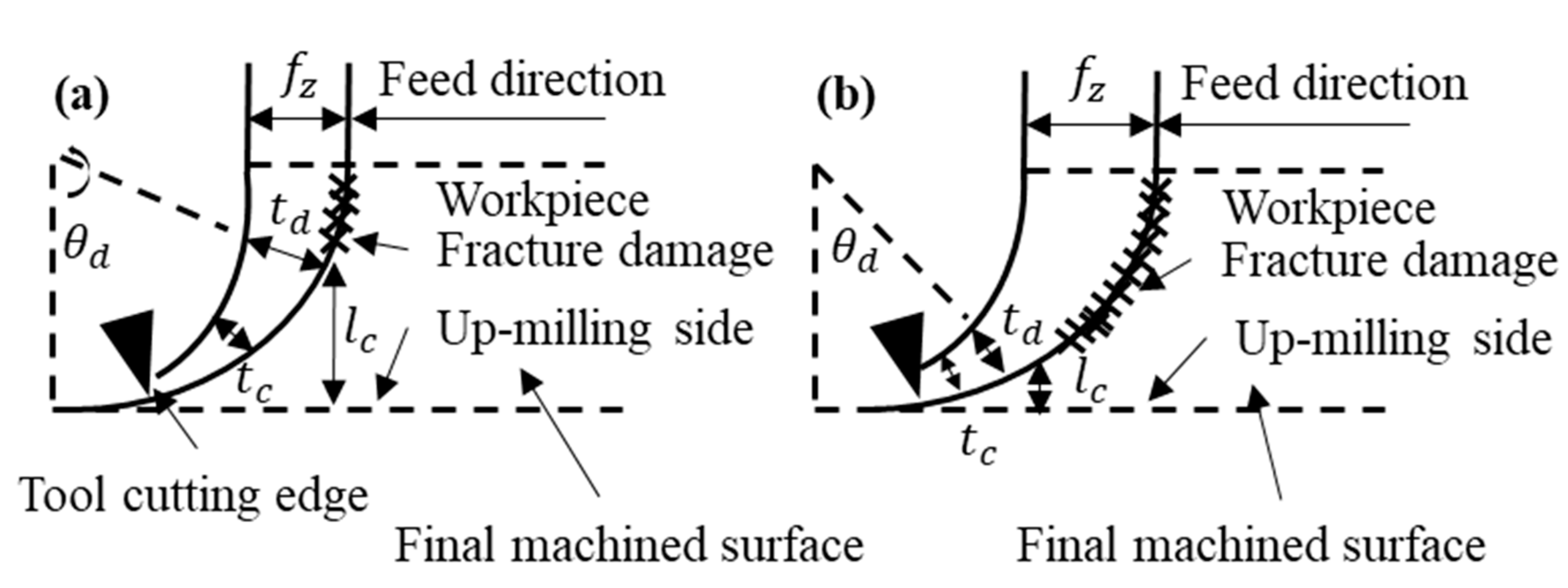
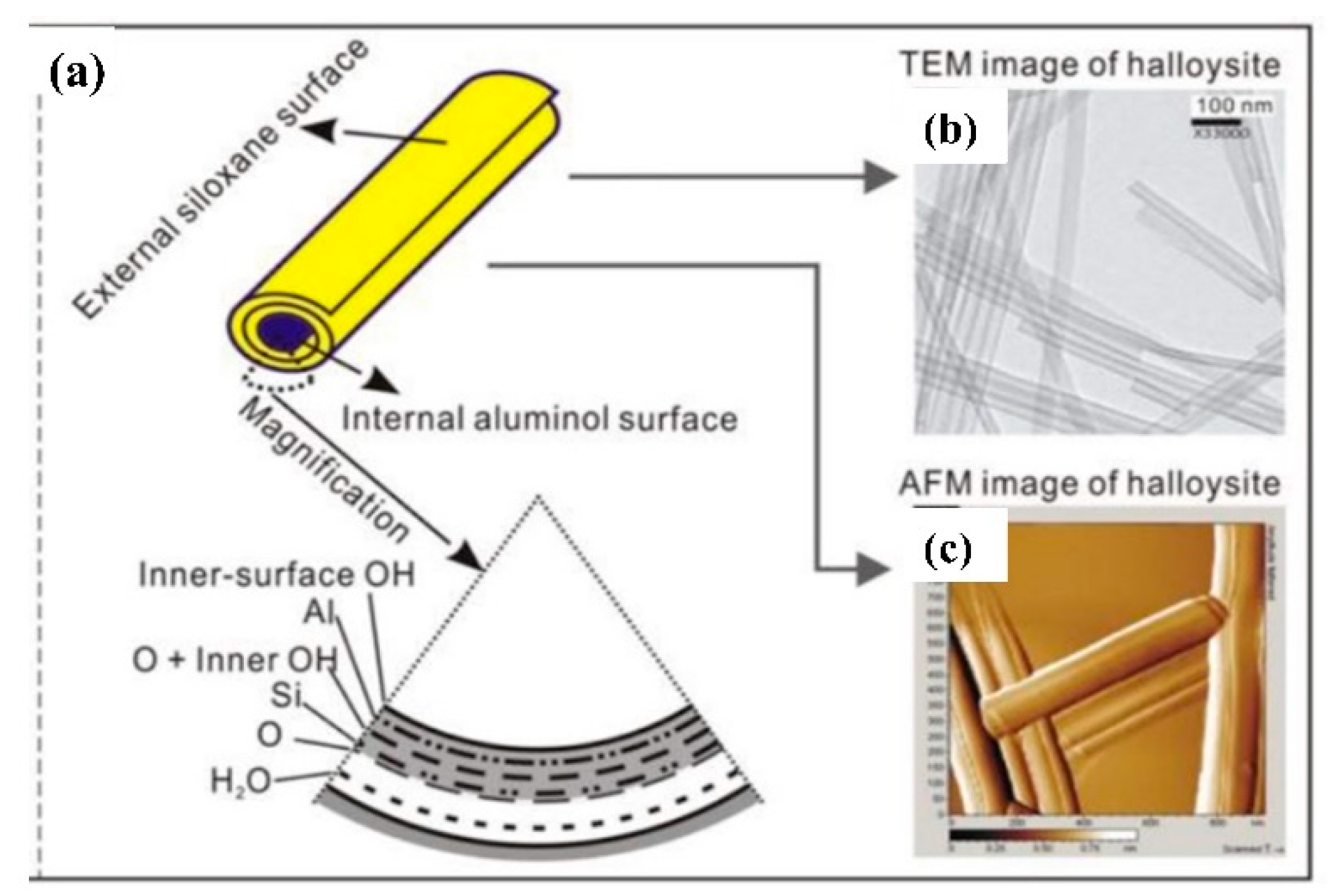
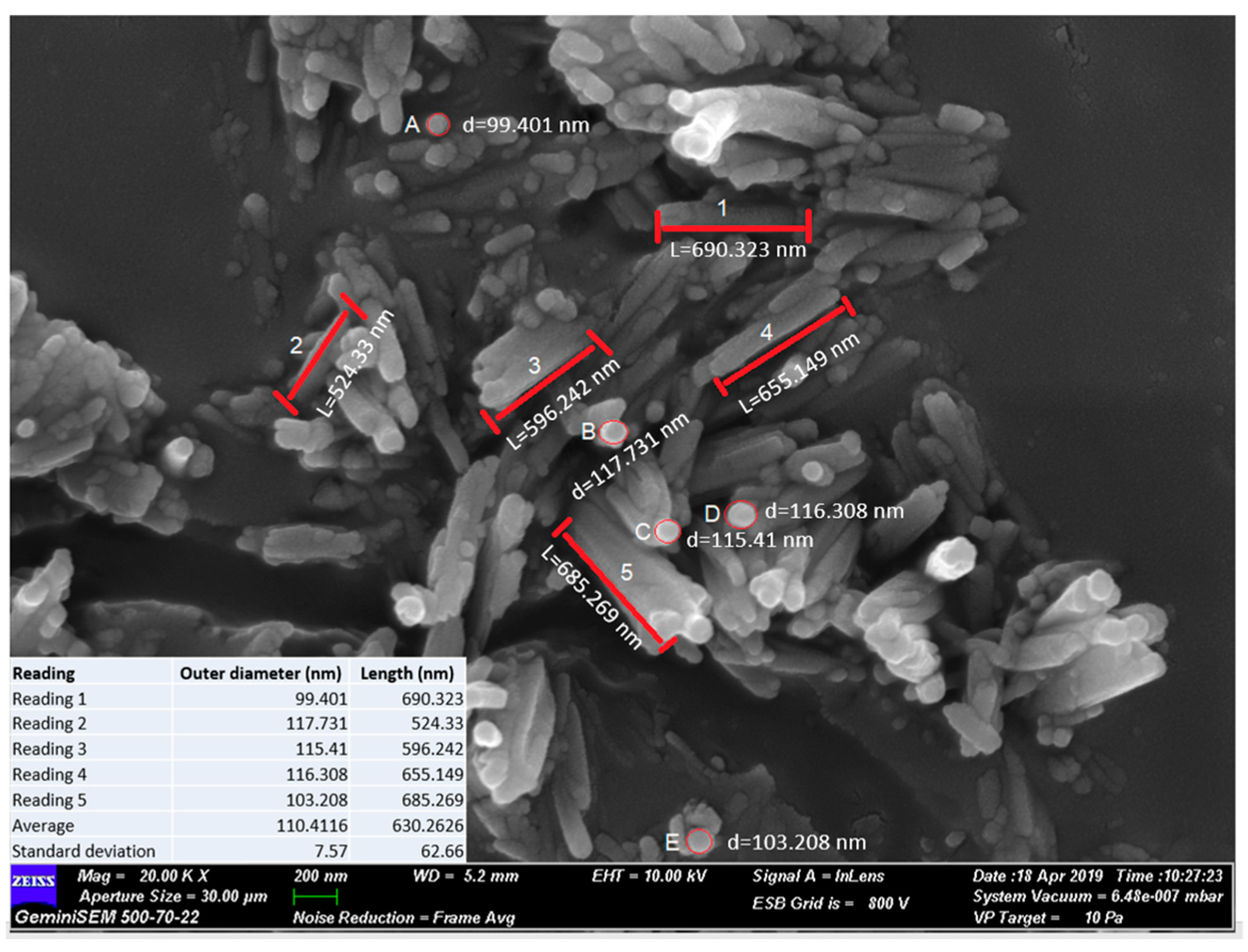
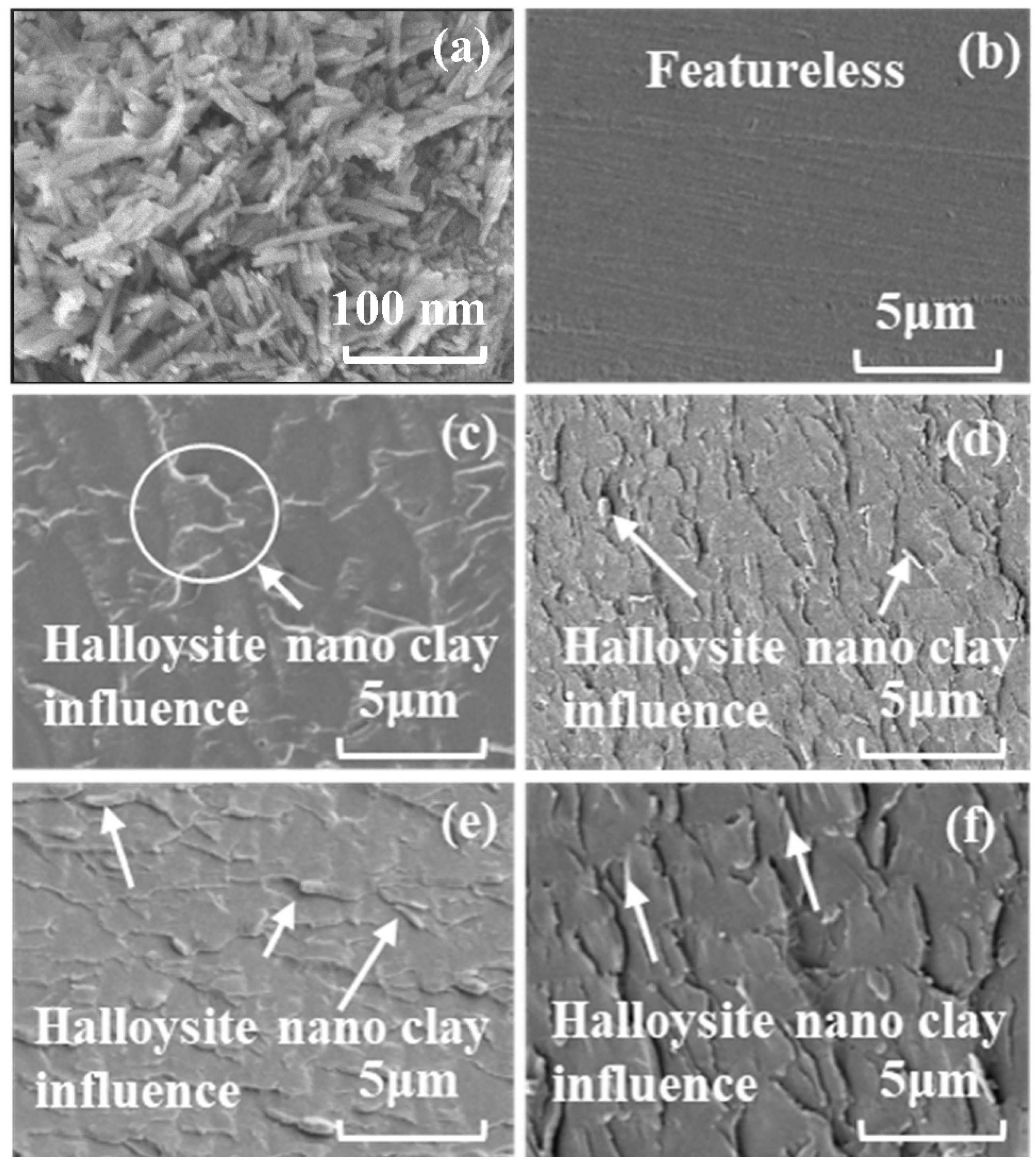
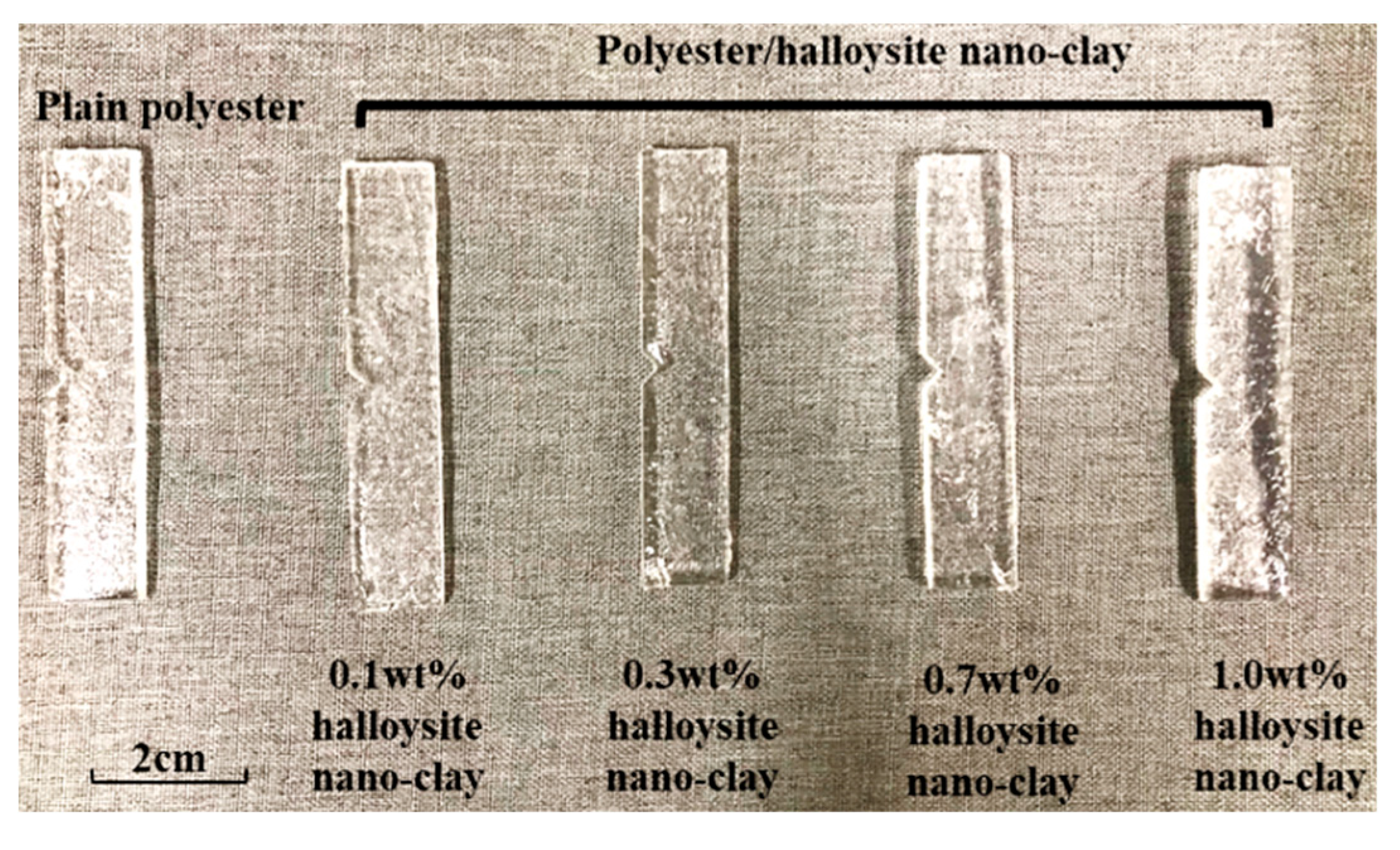
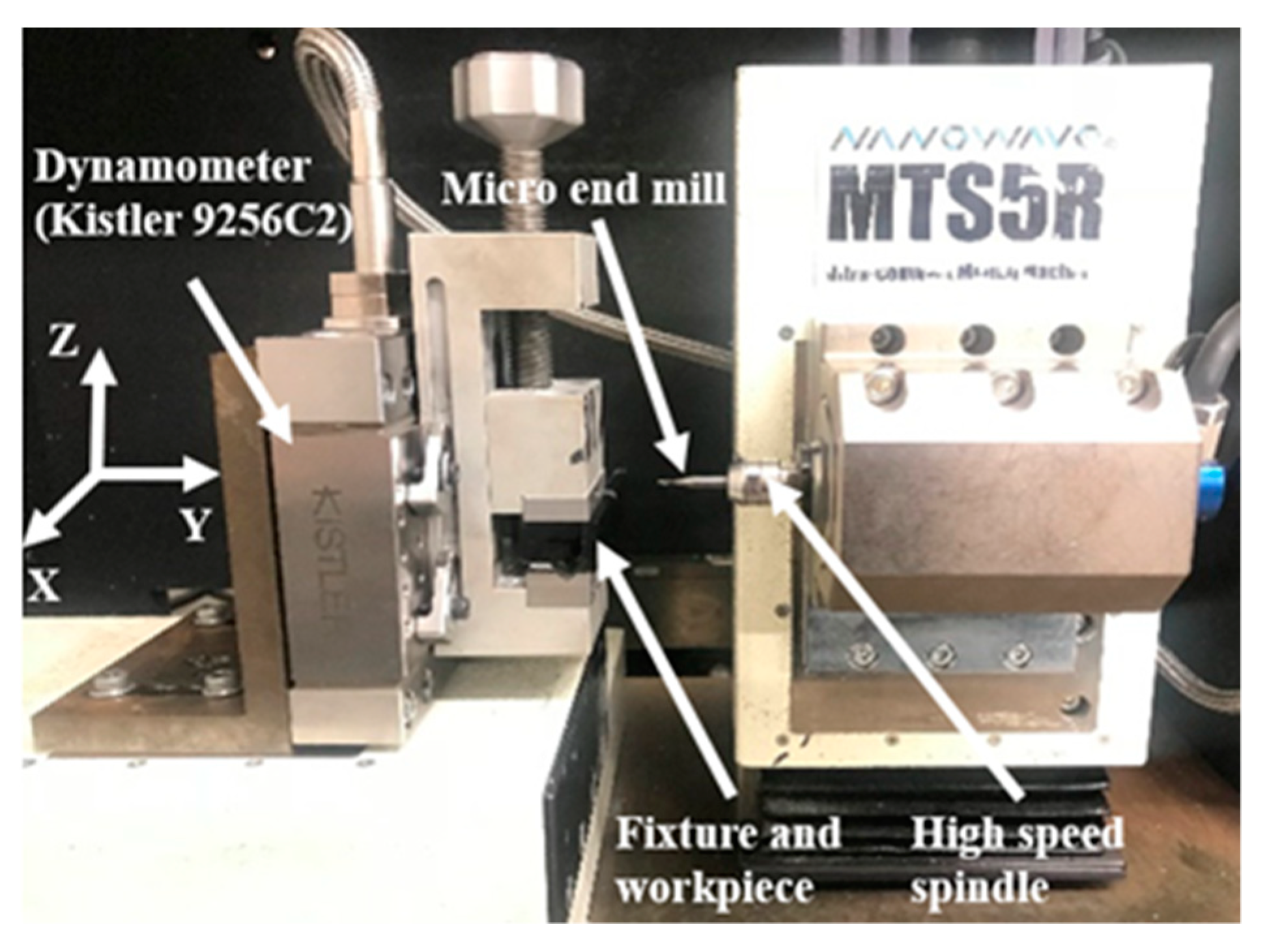
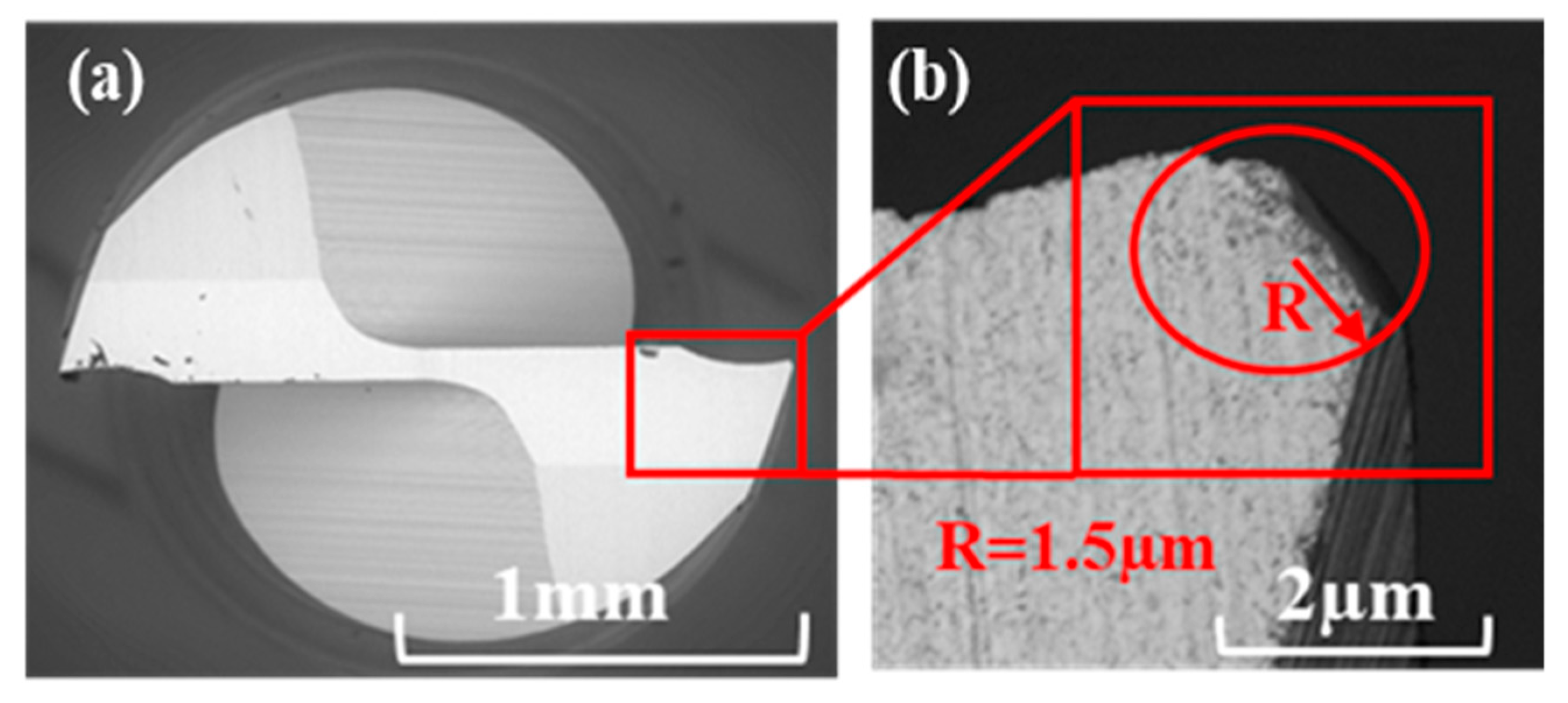
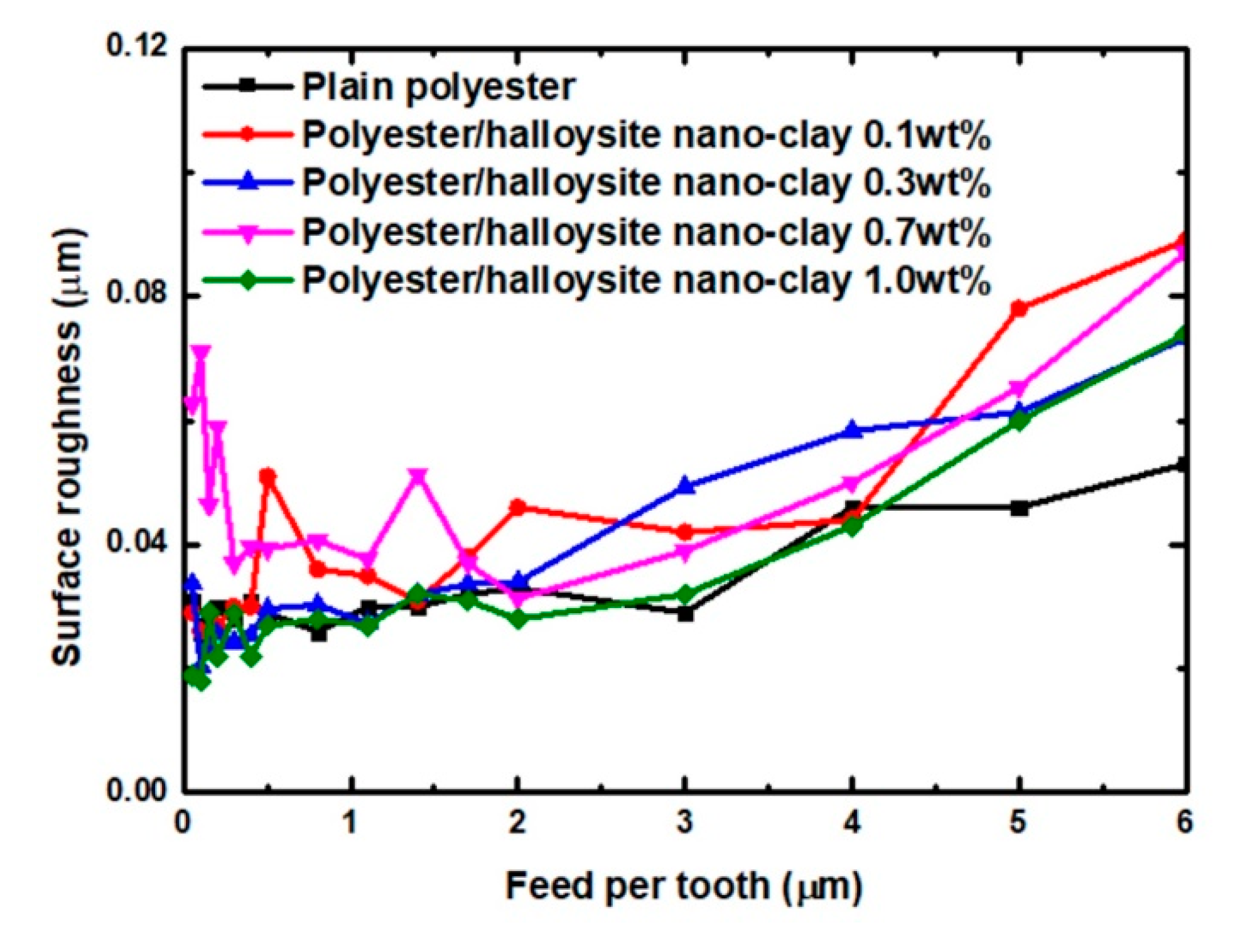
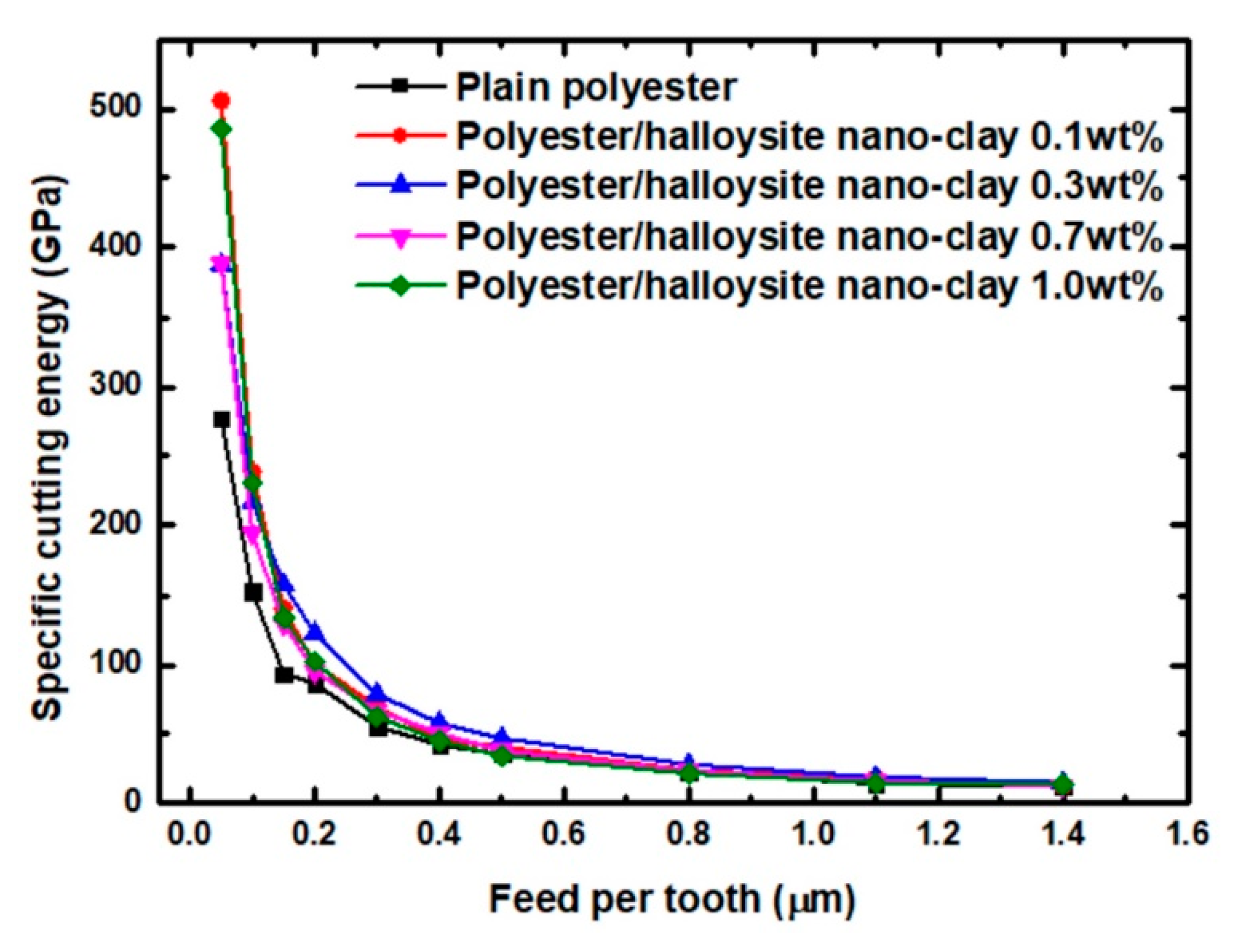
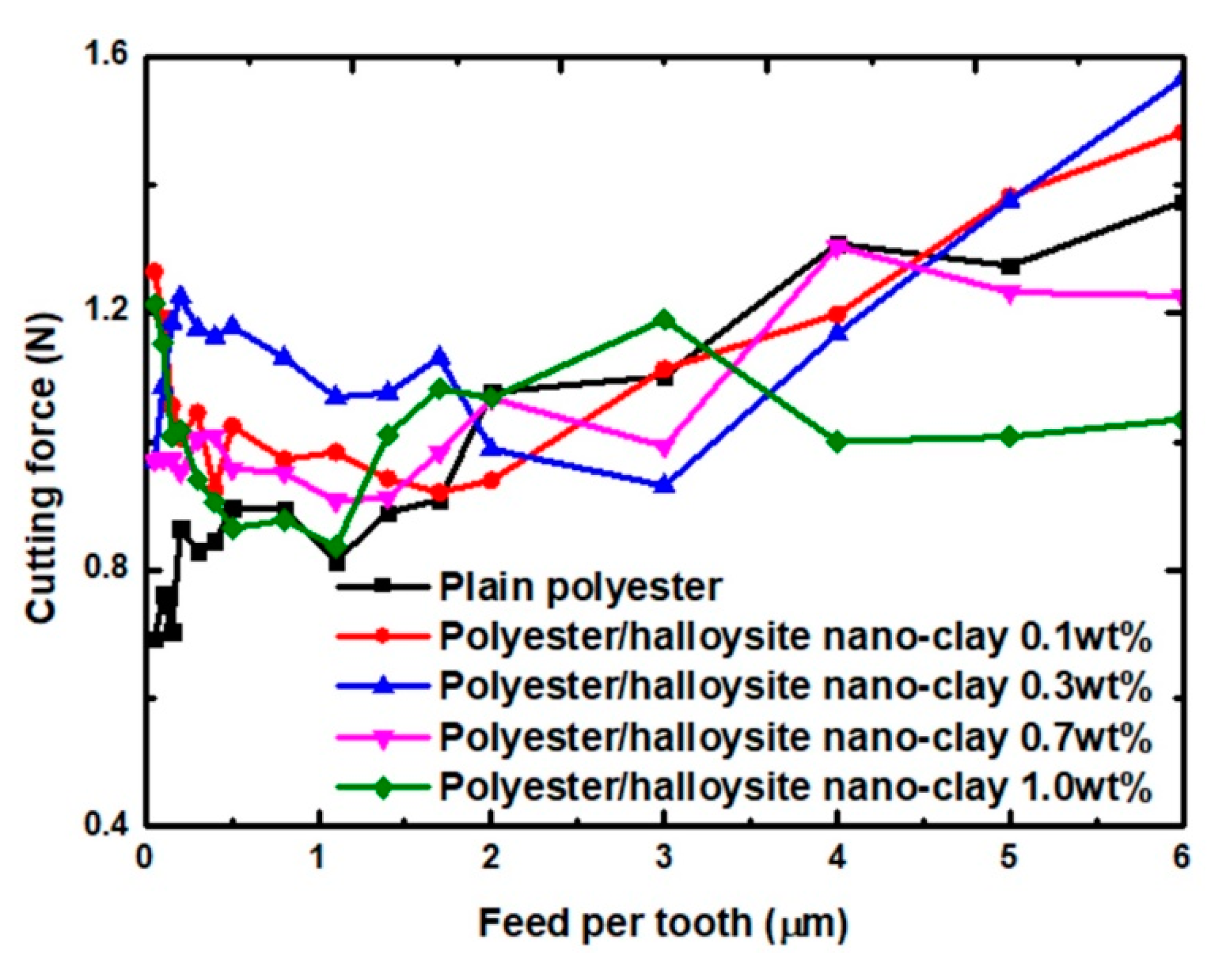
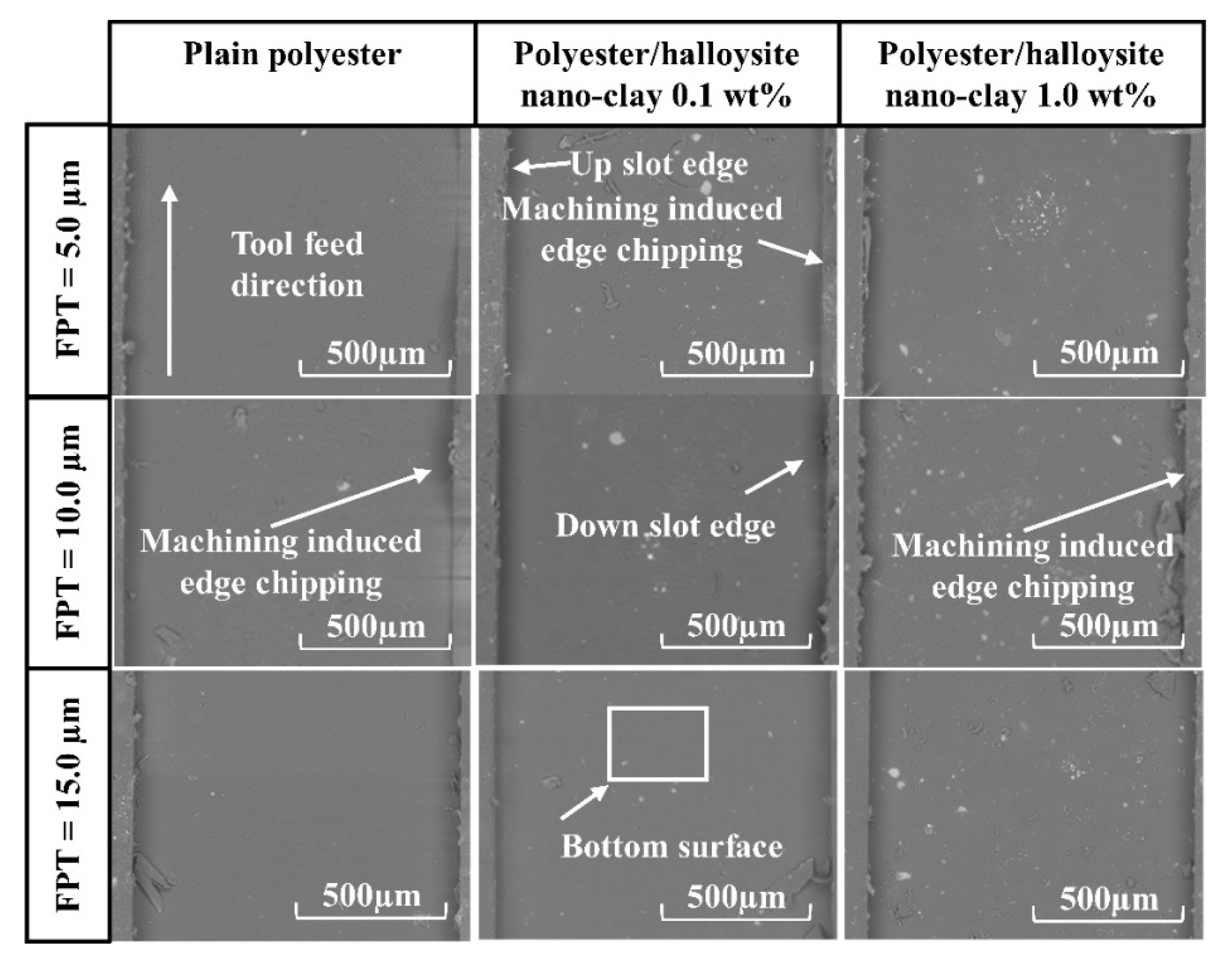
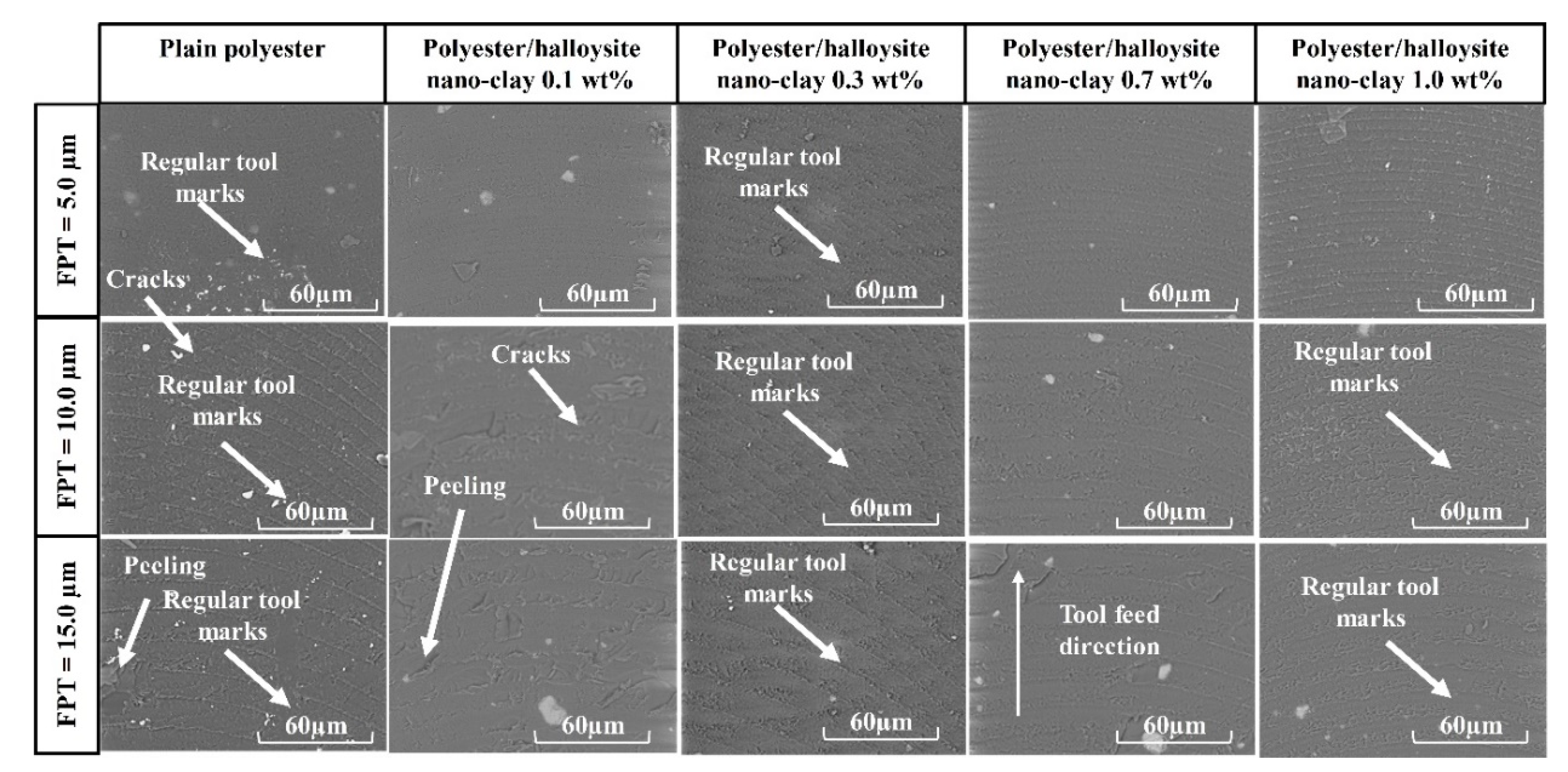
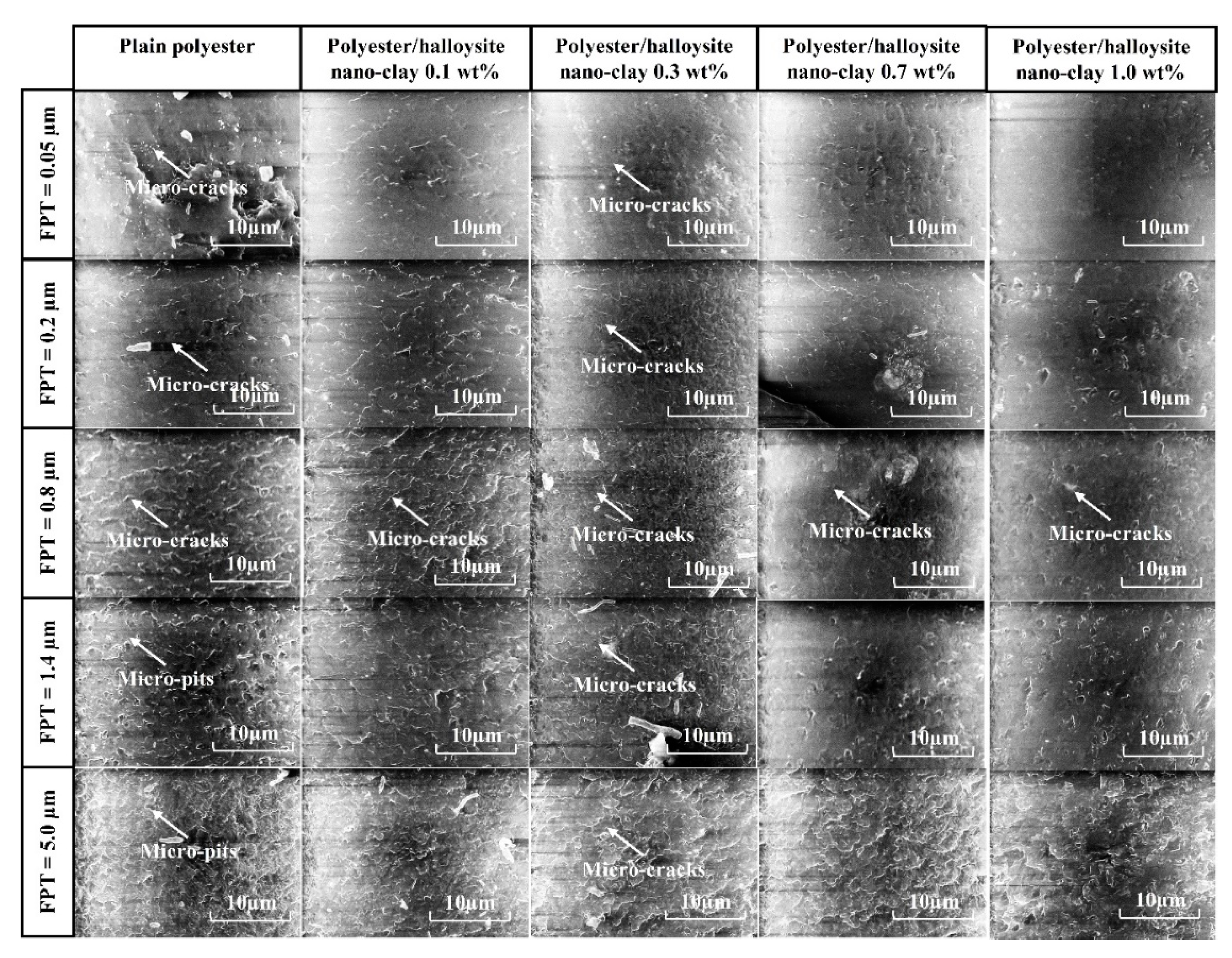
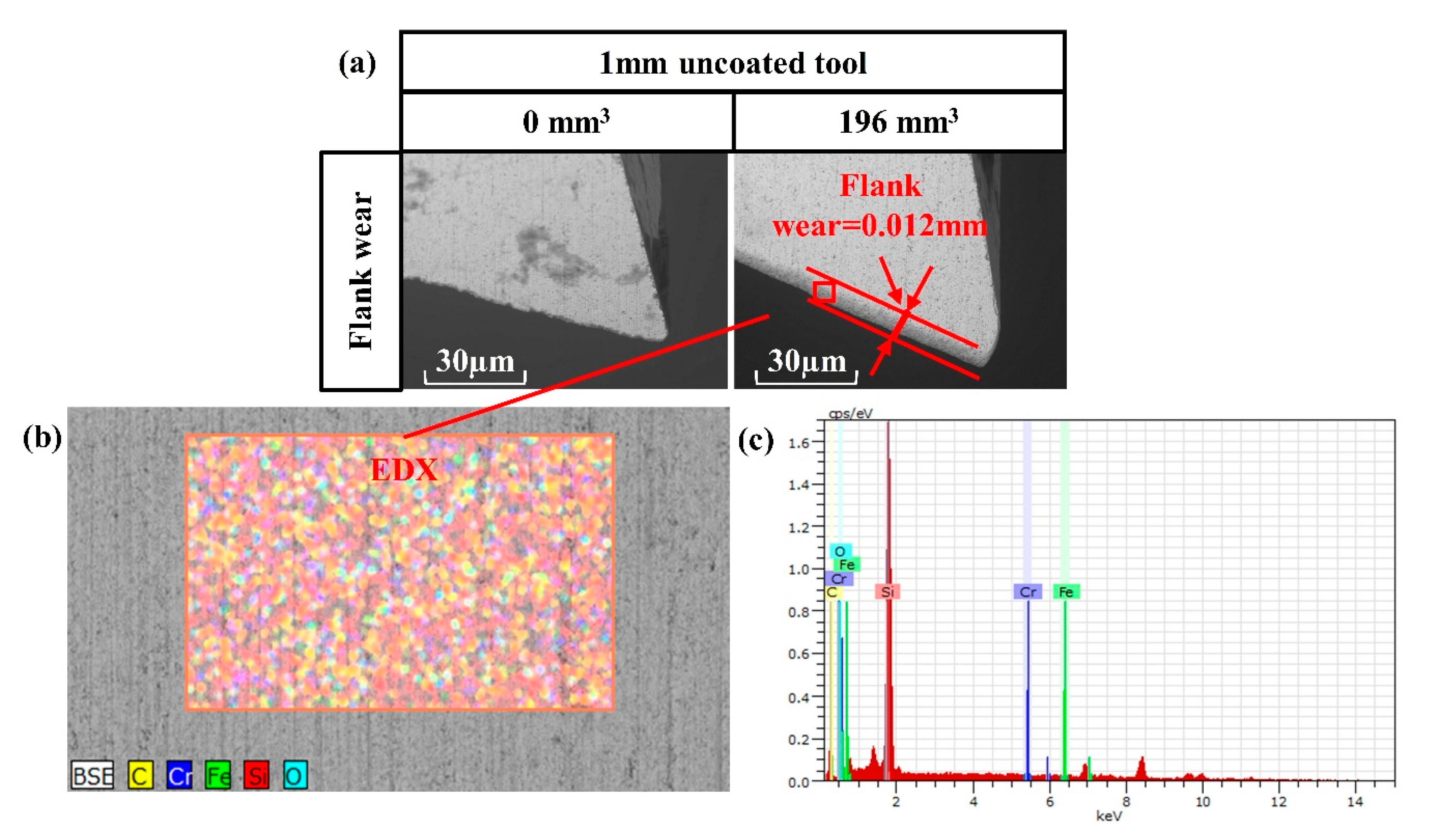
| Properties | Value |
|---|---|
| Tool diameter | 1 mm |
| Number of Flutes | 2 |
| Helix Angle | 30° |
| Tool edge radius | 1.5 µm |
| Cutting Parameters | Level 1 | Level 2 | Level 3 | Level 4 | Level 5 | Level 6 |
|---|---|---|---|---|---|---|
| Feed per tooth (µm) | 5 | 10 | 15 | / | / | / |
| Feed rate (µm/tooth) | 10 | 20 | 30 | / | / | / |
| Cutting speed (m/min) | 15.7 | 31.4 | 62.8 | 94.2 | 125.6 | 188.4 |
| Spindle speed (rpm) | 5000 | 10,000 | 20,000 | 30,000 | 40,000 | 60,000 |
| Depth of cut (µm) | 100 | / | / | / | / | / |
| Feed per Tooth (µm/tooth) | Cutting Speed (m/min) | Spindle Speed (rpm) | Depth of Cut (µm) |
|---|---|---|---|
| 0.05, 0.1, 0.15, 0.2, 0.3, 0.4, 0.5, 0.8, 1.1, 1.4, 1.7, 2.0, 3.0, 4.0, 5.0, 6.0 | 62.8 | 40,000 | 100 |
© 2019 by the authors. Licensee MDPI, Basel, Switzerland. This article is an open access article distributed under the terms and conditions of the Creative Commons Attribution (CC BY) license (http://creativecommons.org/licenses/by/4.0/).
Share and Cite
Fu, G.; Huo, D.; Shyha, I.; Pancholi, K.; Saharudin, M.S. Experimental Investigation on Micro Milling of Polyester/Halloysite Nano-Clay Nanocomposites. Nanomaterials 2019, 9, 917. https://doi.org/10.3390/nano9070917
Fu G, Huo D, Shyha I, Pancholi K, Saharudin MS. Experimental Investigation on Micro Milling of Polyester/Halloysite Nano-Clay Nanocomposites. Nanomaterials. 2019; 9(7):917. https://doi.org/10.3390/nano9070917
Chicago/Turabian StyleFu, Guoyu, Dehong Huo, Islam Shyha, Ketan Pancholi, and Mohd Shahneel Saharudin. 2019. "Experimental Investigation on Micro Milling of Polyester/Halloysite Nano-Clay Nanocomposites" Nanomaterials 9, no. 7: 917. https://doi.org/10.3390/nano9070917
APA StyleFu, G., Huo, D., Shyha, I., Pancholi, K., & Saharudin, M. S. (2019). Experimental Investigation on Micro Milling of Polyester/Halloysite Nano-Clay Nanocomposites. Nanomaterials, 9(7), 917. https://doi.org/10.3390/nano9070917







